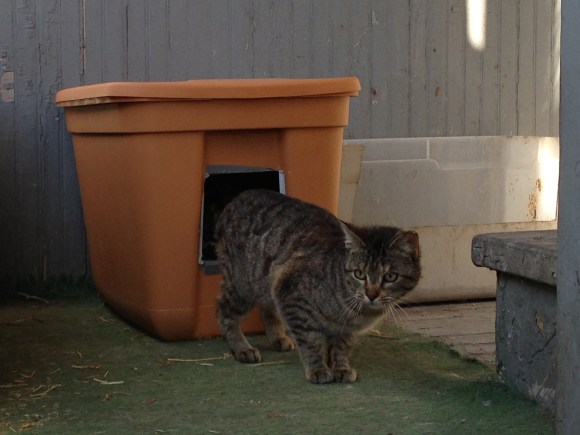Learn How to Trap-Neuter-Return by Volunteering
You can gain hands-on experience and learn how to TNR by volunteering.
Last spring I volunteered with Tree House Humane Society to help a woman caring for a colony of 29 cats in her yard, called the Luna Colony. She was an overwhelmed feeder who was elderly and living alone and could not TNR by herself. She had cats in and out of her home and the colony was bonded to her. They did not have adequate shelter and were spraying her yard. As a result, some of the cats were sick. She needed help with TNR as well as proper colony maintenance.
The cats were there as soon as we arrived.
 We baited and set up Tru-Catch Traps in the alley, and then brought them inside the yard so as not to disturb the cats with too much activity first.
We baited and set up Tru-Catch Traps in the alley, and then brought them inside the yard so as not to disturb the cats with too much activity first.
 We found out a mother cat had just given birth minutes before we arrived. Luckily we trapped her first and put her newborn kitten in the trap with her. Tree House staff drove her straight to their vet clinic.
We found out a mother cat had just given birth minutes before we arrived. Luckily we trapped her first and put her newborn kitten in the trap with her. Tree House staff drove her straight to their vet clinic.

The rest of us stayed and continued trapping. This is why it’s great to tag-team on TNR. The mother cat was in crisis but only one person had to leave with her to handle it and we could continue as planned.
All 29 cats were trapped over a period of a few days. Some of the cats needed additional medical treatment and had to be recovered a few extra days. The last were returned to the yard 11 days after the project started.
After I returned these cats, some of the cats came to check me out and show off their new ear tips. They mostly hang out on the feeder’s back porch.
In addition to TNR, volunteers added new outdoor cat shelters made out of Rubbermaid bins on and under the porch.

Since the porch is covered from rain and snow, they also added shelters made from styrofoam coolers stuffed with straw. The cats love them.

The feeder already had some sturdy shelters in the yard so the volunteers utilized those, just making sure they were now full of clean straw. They also cleaned the yard and added fresh mulch on bare patches.

The feeder gives the cats wet food on the back porch, but also keeps dry food in this covered feeding station so the cats can eat throughout the day.

Volunteers also added outdoor litter boxes and even scratching posts made of discarded tree trunks. Every time I volunteer I learn something new – I loved the idea of using these tree trunks!

With the help of volunteers doing TNR, this feline colony’s population is now under control and the cats are cared for. The feeder could not have done all of this without their help.


